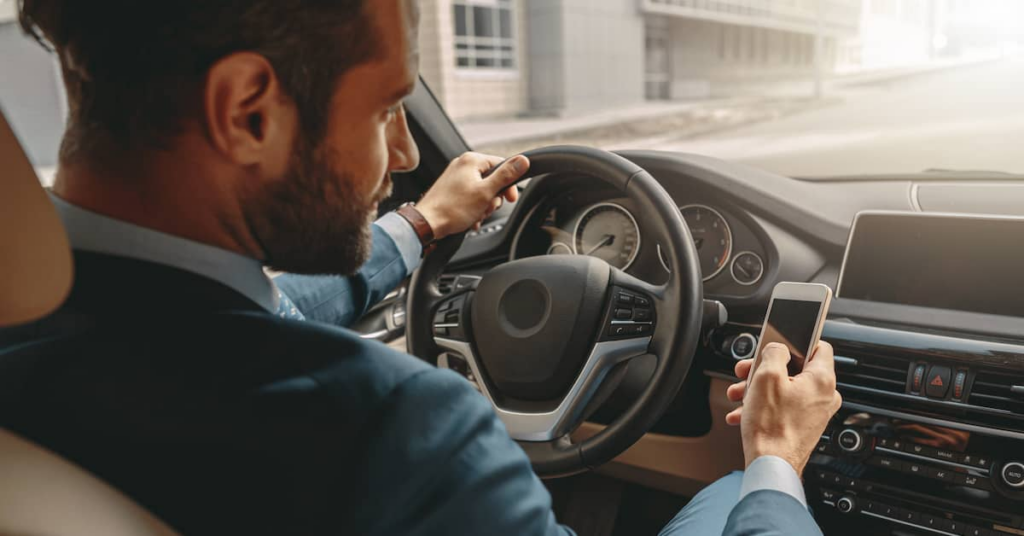
A distracted driving lawyer can help if you were injured or lost a loved one in a crash caused by an inattentive motorist. Many different distractions can lead to auto accidents. Our knowledgeable attorneys can collect evidence on your behalf and pursue the compensation you deserve.
Please call The Flood Law Firm at (860) 346-2695 today for a FREE consultation with a distracted driving lawyer. We serve clients throughout Connecticut from offices in Middletown, Danbury, Waterbury, and Bridgeport.
What Is the #1 Distraction While Driving?
1. Texting and Driving
It should come as no surprise that texting is the number-one concern when it comes to distracted driving. The National Highway Traffic Safety Administration (NHTSA) identifies it as the “most alarming distraction” on our nation’s roads.
According to the NHTSA, a driver’s eyes are off the road for approximately 5 seconds when they read or respond to a text behind the wheel. If the distracted motorist is traveling at 55 mph, they can drive the length of a football field without looking at the road.
Reading a text or writing a text both involve multiple forms of distraction:
- Visual: The driver’s eyes are not on the road, significantly increasing the risk of a collision.
- Manual: The driver does not have both hands on the wheel, reducing control of the vehicle.
- Cognitive: The driver’s attention is divided between the cell phone and operating a motor vehicle. Driving is a task that demands complete focus. Key aspects of safe driving (such as decision making) suffer if the mind of the motorist is elsewhere.
Other types of distractions may impact one or some combination of these essential functions of safe driving. However, texting and driving affects all three of a driver’s capabilities, making it one of the most dangerous things motorists can do behind the wheel.
What Are Some Other Common Distractions That Lead to Car Accidents?
Distractions creep into all aspects of our lives. While some drivers are able to tune out the distractions and focus on the road, many others are not.
Other distractions that commonly lead to car accidents include:
2. Talking on the Phone While Driving
Although texting is the main focus of efforts to curb distracted driving, other forms of mobile phone use also pose a danger. Talking on the phone is a manual and a cognitive distraction that increases the risk of an accident.
In Connecticut, it is against the law for drivers to use a handheld mobile device while driving. This includes talking, texting, and more. Further, drivers under the age of 18 are prohibited from using a mobile device – even hands-free technology – except in an emergency.
3. Distractions Inside the Vehicle
A vehicle’s dashboard can present a number of different distractions. Drivers might take their eyes off the road for only a second when they do the following, but that second can mean the difference between stopping in time and getting into a collision:
- Adjusting the car’s climate control settings
- Operating the car’s radio or audio system (i.e., changing stations or music tracks, adjusting the volume, etc.)
- Looking at a GPS or navigation device
4. Eating and Drinking
Food items and beverages are a handful. When driving, it is important for drivers to have both hands on the wheel, not focused on a snack or a drink.
Eating and drinking can also be a visual distraction. This is especially the case if the driver has to look away from the road to reach for a cup, a wrapper, or a container, or if a spill occurs while driving.
5. Grooming
Many drivers treat the morning commute as an opportunity to finish getting ready for the day. You might see other motorists applying makeup, brushing or combing their hair, and more. These activities are significant distractions that can lead to an accident.
6. Lack of Attention
Distracted driving accidents often occur because drivers try to multitask behind the wheel. In other cases, however, simple inattention on the part of a driver can lead to a crash.
Sometimes drivers will allow their minds to wander. They might even “zone out” and think about other things when they are on the road, which can lead not only to a lack of attention but a loss of control of the vehicle.
7. Interactions with Passengers
Noisy and unruly passengers can prove to be hugely distracting for drivers. This is especially true for teen drivers, whose inexperience behind the wheel is often compounded by the inconsiderate behavior of friends inside the vehicle.
8. Children and Pets
It is very easy for parents and pet owners alike to turn their eyes, hands, and minds away from the road to tend to a child or animal. Parents should teach their children to be on their best behavior when they are in the car. Ideally, pets can be transported in a carrier so the animal isn’t moving around inside the vehicle.
9. Stress
Emotions can play a major role in safe driving. Drivers who are stressed out, angry, or upset may not be thinking clearly, which can lead to erratic and distracted behavior. Strong negative emotions can even turn into aggressive driving, which significantly increases the likelihood of the driver getting into an accident.
10. Distractions Outside the Vehicle
Finally, objects and events outside the vehicle can draw the driver’s attention and lead to an accident. This may include:
- Looking for an address, a turn, an on ramp or off ramp, etc.
- The activities of other motorists inside their vehicles
- Signs and billboards
- Trying to find an open parking space
- Wildlife on or near the road
- “Rubbernecking,” or looking at the scene of a vehicle accident
Contact a Distracted Driving Lawyer Today
After an accident, it can be difficult to prove that the other driver was distracted. Distractions tend to be short-lived, but the consequences can last a lifetime.
It is crucial to speak to an attorney as soon as possible if you were injured or a member of your family was killed in an accident with a distracted driver. A distracted driving lawyer can investigate, collect evidence, and pursue full compensation on your behalf.
